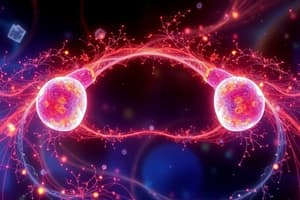Podcast
Questions and Answers
What primarily drives the development of Type 2 Diabetes Mellitus (T2DM) after years of insulin resistance?
What primarily drives the development of Type 2 Diabetes Mellitus (T2DM) after years of insulin resistance?
- Dysregulated lipid and glucose metabolism (correct)
- Decreased physical activity only
- Excess carbohydrate storage in muscles
- Abnormal calcium metabolism
Which statement best describes the initial phase of the twin cycle hypothesis?
Which statement best describes the initial phase of the twin cycle hypothesis?
- Skeletal muscle typically clears nutrients efficiently.
- Liver function remains entirely unaffected.
- It begins with excess caloric intake without resistance.
- Early insulin resistance marks the beginning of the cycle. (correct)
What is the consequence of a positive energy/caloric balance and prolonged insulin secretion on skeletal muscle and subcutaneous fat?
What is the consequence of a positive energy/caloric balance and prolonged insulin secretion on skeletal muscle and subcutaneous fat?
- Onset of insulin resistance in these tissues (correct)
- Improved insulin sensitivity in muscle
- Increased energy storage in visceral fat
- Enhanced glucose metabolism in the liver
Which of the following is NOT a healthy energy storage depot?
Which of the following is NOT a healthy energy storage depot?
What happens to circulating glucose levels in the bloodstream due to insulin resistance?
What happens to circulating glucose levels in the bloodstream due to insulin resistance?
What is a typical outcome for patients with T2DM when normal energy storage options become saturated?
What is a typical outcome for patients with T2DM when normal energy storage options become saturated?
In the context of the twin cycle hypothesis, what role does leptin play?
In the context of the twin cycle hypothesis, what role does leptin play?
Which organ is primarily affected first in the twin cycle related to T2DM?
Which organ is primarily affected first in the twin cycle related to T2DM?
What primary imbalance contributes to insulin resistance in the liver?
What primary imbalance contributes to insulin resistance in the liver?
What metabolic consequence does steatosis in the liver contribute to?
What metabolic consequence does steatosis in the liver contribute to?
How do elevated circulating free fatty acids (FFAs) specifically affect hepatocytes in T2DM?
How do elevated circulating free fatty acids (FFAs) specifically affect hepatocytes in T2DM?
What is a primary characteristic of 'ectopic' fat deposition in metabolic syndrome/T2DM?
What is a primary characteristic of 'ectopic' fat deposition in metabolic syndrome/T2DM?
Which pancreatic cells are primarily affected in T2DM?
Which pancreatic cells are primarily affected in T2DM?
What is a significant barrier in understanding pancreatic changes in T2DM?
What is a significant barrier in understanding pancreatic changes in T2DM?
What metabolic action does the liver take in response to elevated levels of circulating FFAs?
What metabolic action does the liver take in response to elevated levels of circulating FFAs?
What is an erroneous assumption about the pancreatic tissue in relation to T2DM?
What is an erroneous assumption about the pancreatic tissue in relation to T2DM?
What is the consequence of impaired insulin secretion in the context of insulin resistance?
What is the consequence of impaired insulin secretion in the context of insulin resistance?
Which lipoprotein is specifically involved in the conversion of triglycerides to more cholesterol-rich forms?
Which lipoprotein is specifically involved in the conversion of triglycerides to more cholesterol-rich forms?
What role does ApoE play in lipoprotein metabolism?
What role does ApoE play in lipoprotein metabolism?
In insulin resistance, what happens to the secretion levels of leptin and adiponectin?
In insulin resistance, what happens to the secretion levels of leptin and adiponectin?
How do elevated levels of LDL contribute to atherosclerosis?
How do elevated levels of LDL contribute to atherosclerosis?
What is the primary function of LPL in relation to VLDL?
What is the primary function of LPL in relation to VLDL?
What factor primarily limits the fat removal capacity of adipose tissue?
What factor primarily limits the fat removal capacity of adipose tissue?
In the twin cycle hypothesis, what is the implication for T2DM development?
In the twin cycle hypothesis, what is the implication for T2DM development?
What was the primary dietary intervention in the DiRECT trial for T2DM patients?
What was the primary dietary intervention in the DiRECT trial for T2DM patients?
Which outcome was NOT observed in the DiRECT trial among participants in the intervention group?
Which outcome was NOT observed in the DiRECT trial among participants in the intervention group?
What was a key criterion for participant eligibility in the DiRECT trial?
What was a key criterion for participant eligibility in the DiRECT trial?
What was the control condition in the DiRECT trial?
What was the control condition in the DiRECT trial?
Which of the following was a significant result reported at 12 months in the DiRECT trial?
Which of the following was a significant result reported at 12 months in the DiRECT trial?
What is one of the three major options the liver has when faced with elevated levels of free fatty acids (FFAs)?
What is one of the three major options the liver has when faced with elevated levels of free fatty acids (FFAs)?
Which of the following apoproteins is NOT a key apoprotein in the structure of VLDL?
Which of the following apoproteins is NOT a key apoprotein in the structure of VLDL?
What is the primary function of VLDL?
What is the primary function of VLDL?
Which of the following correctly describes the life cycle of VLDL?
Which of the following correctly describes the life cycle of VLDL?
What are the primary consequences of hepatic steatosis in the liver?
What are the primary consequences of hepatic steatosis in the liver?
What role do intermediate-density lipoproteins (IDL) play in lipid metabolism?
What role do intermediate-density lipoproteins (IDL) play in lipid metabolism?
Which characteristic of VLDL production is associated with excess fatty acids?
Which characteristic of VLDL production is associated with excess fatty acids?
What happens to LDL after it performs its function in the body?
What happens to LDL after it performs its function in the body?
Flashcards are hidden until you start studying
Study Notes
Twin Cycle Hypothesis and T2DM
- Type 2 diabetes mellitus (T2DM) develops through prolonged insulin resistance, leading to beta cell mass loss and disrupted lipid and glucose metabolism across multiple organs (liver, pancreas, muscle, adipose tissue).
- The twin cycle hypothesis describes the interactions between insulin resistance and dysregulated metabolism, emphasizing the impact of caloric intake and nutrient clearance.
The "First" Cycle – The Liver
- Diabetic patients experience a "tipping point" where energy storage depots (subcutaneous fat, muscle, liver) become saturated.
- Insulin resistance in skeletal muscle and subcutaneous fat reduces their capacity to store energy, resulting in elevated circulating glucose and free fatty acids (FFAs).
- The liver responds to high FFAs through three options: beta oxidation (burning), hepatic steatosis (storing), and VLDL (exporting).
- Insulin resistance causes lipid accumulation in the liver, leading to steatosis, which exacerbates gluconeogenesis and increases blood glucose levels, triggering further insulin secretion.
Elevated Free Fatty Acids and Ectopic Fat Deposition
- Elevated FFAs from insulin-resistant adipocytes contribute to hepatic steatosis and inadequate fatty acid clearance from circulation.
- The liver repackages excess FFAs into triglycerides or lipids, enhancing the risk of steatosis in T2DM.
- Ectopic fat deposition often occurs within skeletal muscle and pancreas, further aggravating insulin resistance.
The "Second" Cycle – The Pancreas
- The pancreas's role in T2DM progression has been historically underexplored due to its deep location and difficulty in sampling.
- Insulin resistance leads to fat accumulation (triglycerides and FFAs) in the pancreas, which can impair insulin secretion and lead to hyperglycemia.
- Increased VLDL and associated inflammation from T2DM elevate the risk for atherosclerosis.
Subcutaneous Fat Saturation
- Adipose tissue has a limit on how much fat it can sequester, influenced by genetics, sex, and age.
- In insulin-resistant states, adipocytes struggle to build triglycerides and instead release FFAs, disrupting the balance of leptin and adiponectin.
- Increased leptin and relative adiponectin resistance contribute to poor regulation of food intake.
Evidence and Research
- The twin cycle hypothesis requires further investigation regarding its validity and the physiological changes accompanying T2DM treatments.
- Studies like the DiRECT trial reveal promising outcomes by demonstrating significant weight loss and potential improvements in liver and pancreatic fat in a controlled setting.
- The trial involved a structured weight-loss program with notable reductions in weight among participants and cessation of medications.
Studying That Suits You
Use AI to generate personalized quizzes and flashcards to suit your learning preferences.



